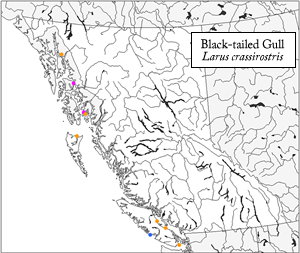Breeding adult
This plumage is held between ~February/March and ~September/October. The mantle, including the back, scapulars, and most of the upperwings, is dark slate-grey. The wingtips are black and the secondaries and inner primaries sport a relatively narrow, but sharply defined, white trailing edge, breaking into white spots at the tips of the outer primaries. The underwings are white with black wingtips (shading to dark grey on inner primaries). The rump and uppertail coverts are white. The tail is white with a sharply defined, relatively broad black subterminal band across all but the outer webs of the outer feathers (visible on both upper and lower surfaces of the tail), with narrow dark streaks extending along the shafts of the feathers towards the base of the tail. The head, neck, and underparts are wholly white. The iris is yellow and the orbital ring is red. The bill is relatively slender and straight and is yellow with a black subterminal band and red tip and gonydeal spot. The legs and feet are yellow.
Non-breeding adult
This plumage is held between ~September/October and ~February/March. It is similar to the breeding plumage, but the head and neck have variable dusky clouding and mottling that is usually more heavily concentrated on the hindneck. The bare part colouration is slightly duller than during the breeding season, with the orbital ring becoming grayish or pinkish and the bill and legs becoming slightly duller greenish-yellow.
Third-year immature
This plumage is held between the fall of the third year and the spring of the fourth year, at which time a partial molt results in a “third-summer” plumage that lasts into the fall. This plumage is overall similar to that of the non-breeding adult, although it retains heavier dusky mottling over the head and neck, has reduced or no white on the tips of the primaries, has a duller or greener cast to the bill and legs, and often retains a brownish wash on the upperwing coverts. By the following summer, it is virtually identical to the breeding adult except for the reduced white tips to the primaries.
Second-year immature
This plumage is held between fall of the second year and spring of the third year, at which time a partial molt results in a “second-summer” plumage that lasts into the fall. In comparison to advanced first-year plumages, birds in this plumage have acquired more extensive grey feathers throughout the back, scapulars, and wing coverts, although these are still intermixed with retained brownish feathers. The head, neck, and underparts are paler and more extensively bleached and whitish, particularly on the face, foreneck, breast, and belly. The head, neck, and underparts continue to become whiter throughout the winter, while the amount of grey on the upperparts continues to increase as well. The iris gradually becomes paler, and is often pale grayish or yellowish by the spring. The bill, feet, and legs become grayish or bluish-grey rather than pink. In the “second-summer” plumage, the head, neck, and underparts are more extensively white and the upperparts and more extensively grey, although the wing coverts usually remain mostly brownish. Bare part colouration begins to approach that of the adult.
Juvenile / First-year immature
The juvenile/“first-winter” plumage is held until spring or early summer of the second year, at which time a partial molt produces a “first-summer” plumage that lasts until the fall. The upperparts are dark brown with narrow, sharply defined pale buff fringes on the feathers of the back, scapulars, and wing coverts when fresh. The flight feathers are blackish. The rump and uppertail coverts usually have some pale buff or whitish mottling. The tail is blackish or dark blackish-brown, usually with very narrow pale tips to the feathers. The head and underparts are wholly dark chocolate-brown with some whitish mottling on the undertail coverts and usually a whitish wash on the face. The iris is dark but is offset by narrow white eye-arcs. The bill is pink with a sharply defined black tip. The legs and feet are flesh-pink. Over the course of the winter, the upperparts gradually become more irregularly mottled with buff and grey. This process continues into the summer, during which time the face and underparts become gradually paler and bleached.
Measurements
Total Length: 46-47.5 cm
Mass: 436-640 g
Source: Sibley (2000); Chochi et al. (2002); Howell and Dunn (2007)

